Stay around the Vielles Pierres de Lozère
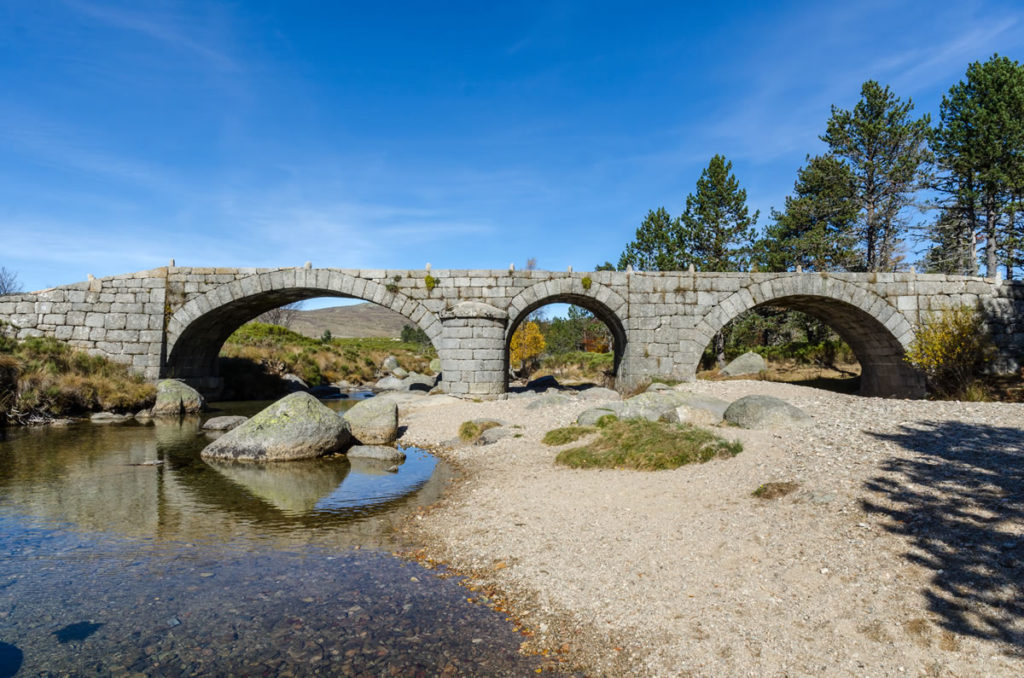
Discovering old lozer stones
Conquers the great outdoors: In unknown land: the lozere.
R
Your program:
The program
D1: arrival at the hotel, taking possession of the room
- Dinner in 1/2 board at Les 2 Rives restaurant
D2: breakfast
- Choosing your place to visit
- 12pm gourmet picnic
- Dinner in 1/2pension at Les 2 Rives restaurant
D3: breakfast
- Choosing your place to visit
- 12pm gourmet picnic
- Dinner in 1/2pension at Les 2 Rives restaurant
D4: breakfast
We remind you that all activities must be carried out with the different partners.
ECOMMENDED BY Emilie
These sites natural moments and places
Welcome to the land of evasion!
Labaume Castle
The Museum of Javols and Malzieu Cities
The Roman Mausoleum
The Château du Tournels
Rune’s Casade!
The day of all possible
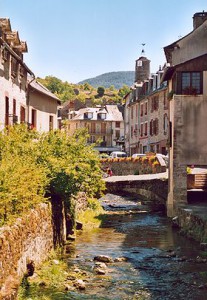
From Banassac crossing La Canourgue « Little Lozérian Venice ».
A village that we advise you to visit when you arrive with us, but it is imperative to have visited before leaving. The canals will seduce you, in fact in our country it is missing only the boats.
The Château de La Baume
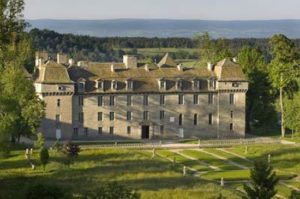 Located in the Massif Central at 1200 meters above sea level, La Baume is a private castle, classified as a historical monument. It is one of the tallest castles in France and is inhabited all year round. The Las Cases family has maintained and animated this monument for a century and a half, thus actively participating in the influence of a historical and cultural heritage close to its heart. It strives to make this castle a lively and lively place in which the visitor can rediscover a heritage accumulated since the 17th century and always preserved with passion.
Located in the Massif Central at 1200 meters above sea level, La Baume is a private castle, classified as a historical monument. It is one of the tallest castles in France and is inhabited all year round. The Las Cases family has maintained and animated this monument for a century and a half, thus actively participating in the influence of a historical and cultural heritage close to its heart. It strives to make this castle a lively and lively place in which the visitor can rediscover a heritage accumulated since the 17th century and always preserved with passion.
What to see on the way
- Nasinals and the derocal waterfall
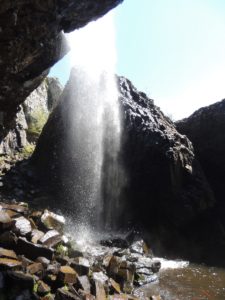
The Deroc waterfall dominates the small glacial valley of the Gambaïse Creek by 30 metres: stunning views of the Marchastel region with, in the background, the vast expanses of the Lozerian granite Aubrac.
Access to the waterfall is a small path from the town of Nasbinals. Following the stream, we arrive at the edge of the ravine. There, the tributary of the Bès and the waters of Lake Salhians rush from the basalt ledge under which a cave was formed. Its ceiling is made up of large basaltic prisms remarkable for their geometry.
- Trelans
Take this winding road on the foothills of the aubrac, a peaceful and ranquile moment that will allow you to enjoy landscape to cut the breath. Unique moments
The Museum of Javols and Malzieu Cities
The Javols Museum
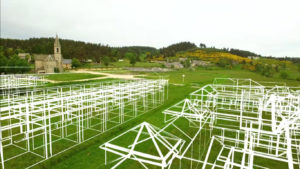
The city of Anderitum was built shortly after Caesar conquered the Gauls.
In the lower part of the Triboulin, a roman-built town is well protected by the sediments of the valley floor. It has a forum, public administrative and justice buildings, a performance building and two baths. Only the temples remain unknown to this day.
The city of Anderitum reached its peak (40 ha) in the 2nd century, thanks to the peace and economic dynamics of the Roman Empire. Although it gradually lost its status as the capital in the early Middle Ages to Mende, the city remained the chief place of the Gabales, « ad Gabalos », until the 7th century. The first Christian community had to reside there
The Malzieu-City, The Pearl of the Valley.
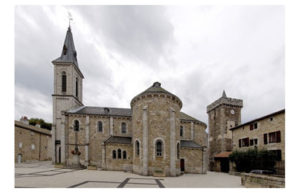
Let yourself be captivated by the charm of the cobbled streets, fortified towers, ramparts and beautifully restored gates. A short walk or a historical visit, a discovery of the Ursuline Museum, everyone will find their happiness in this charming medieval village nestled on the banks of the Truyère.
A city with a turbulent history: The 16th century was marked by the Wars of Religion and the Huguenot captain Mathieu Merle who in 1573 used a ruse to take the walled city, enclosing the city’s notables in the Clock Tower.
After the plague of 1631 and the fire ensued, Italian masons helped rebuild the village. Keep an eye out, and you will no doubt discover these magnificent monumental gates so characteristic!
To be seen on the way
- English castle at new hiking castle
Drive up to the heart of the village of Châteauneuf de Randon and see the English Tower and the orientation table with its 360-degree view.
- Charpal Lake
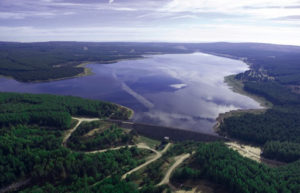
An artificial lake created between the two wars for the purposes of the army to submerge surplus ammunition, this is how the construction of a railway line in 1923 was explained to carry the materials needed to build the dam and ammunition, but the project was not successful. Today a drinking water reserve in the city of Mende. The lake is also known for its wildlife and floristic richness. This lake offers landscapes worthy of the ambience of Canada’s land. An ideal place to walk, discover and recharge with family, couples or friends. Hikers will be able to discover the marked trails around the lake. The largest no-kill lake in France, it will also appeal to fishermen, especially for pike and perch fishing.
- The Mende Cathedral
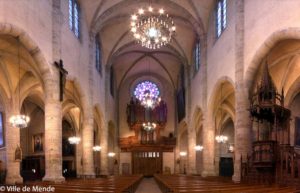
It was in 1368 that Pope Urban V, of Gévauda origin, decided to build the Cathedral of Our Lady and Saint Privat.
In the 16th century, François de la Rovère raised the great bell tower (84 m) in a remarkable Flamboyant Gothic style.
The Cathedral was later enriched by a rich and varied piece of furniture, including Aubusson’s tapestries, dating from 1706 and depicting scenes from the New Testament.
The mausoleum of Lanuéjols
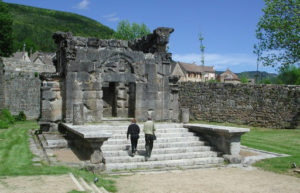 In Lanuéjols there was a vast agricultural estate perhaps located on the site of the present-day Boy Castle. The owners of this estate probably operated iron and copper veins at Mount Lozère. These notables owned a burial pen west of the village of Lanuéjols. About 50 graves were discovered there. Most of these tombs were built with ledge tiles or flat stones. Some were tif covered with mortar
In Lanuéjols there was a vast agricultural estate perhaps located on the site of the present-day Boy Castle. The owners of this estate probably operated iron and copper veins at Mount Lozère. These notables owned a burial pen west of the village of Lanuéjols. About 50 graves were discovered there. Most of these tombs were built with ledge tiles or flat stones. Some were tif covered with mortar
To see in the area
- The castle of the tournels
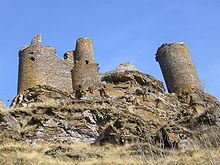 « The Château du Tournel is a feudal castle located on the commune of Saint-Julien-du-Tournel in Lozère. Former seat of the Barons of the Tournel, one of the eight baronies of Gévaudan, it was destroyed during the Wars of Religion by the Huguenot troops of Matthieu Merle. »
« The Château du Tournel is a feudal castle located on the commune of Saint-Julien-du-Tournel in Lozère. Former seat of the Barons of the Tournel, one of the eight baronies of Gévaudan, it was destroyed during the Wars of Religion by the Huguenot troops of Matthieu Merle. »
- Charpal Lake

An artificial lake created between the two wars for the purposes of the army to submerge surplus ammunition, this is how the construction of a railway line in 1923 was explained to carry the materials needed to build the dam and ammunition, but the project was not successful. Today a drinking water reserve in the city of Mende. The lake is also known for its wildlife and floristic
richness. This lake offers landscapes worthy of the ambience of Canada’s land. An ideal place to walk, discover and recharge with family, couples or friends.
Hikers will be able to discover the marked trails around the lake.
The largest no-kill lake in France, it will also appeal to fishermen, especially for pike and perch fishing.
- Mende Cathedral

It was in 1368 that Pope Urban V, of Gévauda origin, decided to build the Cathedral of Our Lady and Saint Privat.
In the 16th century, François de la Rovère raised the great bell tower (84 m) in a remarkable Flamboyant Gothic style.
The Cathedral was later enriched by a rich and varied piece of furniture, including Aubusson’s tapestries, dating from 1706 and depicting scenes from the New Testament.
The castle of Tournel
 « The castle of Tournel is a feudal castle located on the commune of Saint-Julien-du-Tournel in Lozère. Former seat of the Barons of the Tournel, one of the eight baronies of Gévaudan, it was destroyed during the Wars of Religion by the Huguenot troops of Matthieu Merle. »
« The castle of Tournel is a feudal castle located on the commune of Saint-Julien-du-Tournel in Lozère. Former seat of the Barons of the Tournel, one of the eight baronies of Gévaudan, it was destroyed during the Wars of Religion by the Huguenot troops of Matthieu Merle. »
To see in the area
- The Montvert Bridge
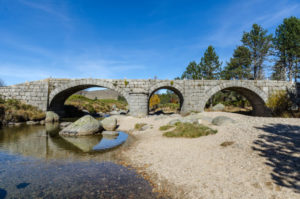
17th century bridge with, at its entrance, a square tower that was to be used as a toll office, during the passage of herds of transhumant sheep.
This church was given in 1187 by Bishop Aldebert III to the Knights of St. John of Jerusalem. It was replaced in the 17th century by a larger church. Disused at the time of the concordat, sold in 1826 and turned into a barn and nativity scene, it now lets you see the sky through its collapsed vault. The mus façade is almost intact, but leans dangerously outwards. What a regret to see a building that was the only note of medieval architecture in the area die.
- Quezac
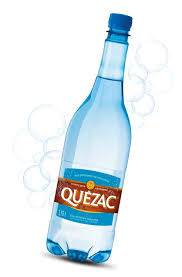
Quézac is located at the gates of the Tarn Gorge, on the left bank of the Tarn in the valley of Quezac and Ispagnac. Access to the village is via a medieval bridge built around 1350 with funding from Pope
Urban V from Grizac in Lozère. In this typical Lozerian village, narrow street, shale house, lauze roof, discover the church of Our Lady of Quezac remarkable by its porch classified as a Historical Monument.
Quézac is also known for its « Quézac » sparkling mineral water, the source of which is found on the commune.
A green commune par excellence and located in an unusual natural setting, Quézac welcomes you for your stays and holidays in the Tarn Gorge.
- St Enimie
Medieval village,beautiful must Village of France, privileged tourist resort of the Tarn Gorges, … Sainte-Enimie is simply a must!’
The Village of Sainte-Enimie is ranked among the Most Beautiful Villages in France, and once there, you make no mistake!
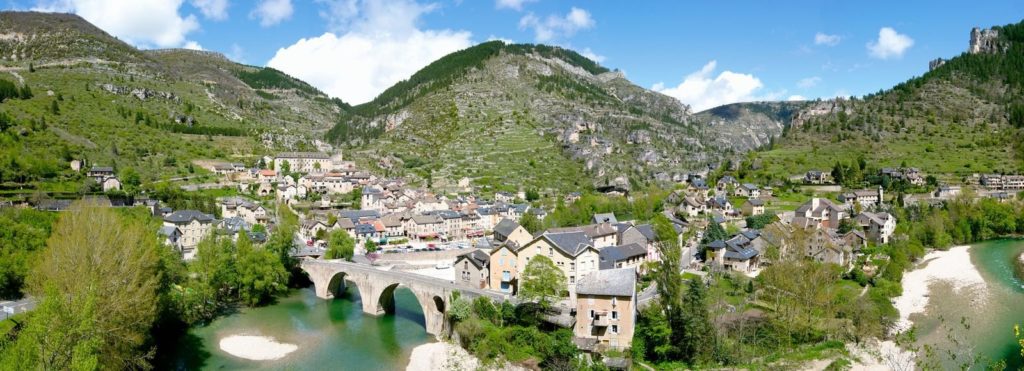
The architecture of Sainte-Enimie denotes as much a strong history as a perfect adaptation to its limestone environment. The origin of the village comes from a monastery built in the 6th century. You can stroll through the old cobbled streets of the Tarn, cross the old houses and the restored squares that have allowed the village to regain its medieval appearance.
In summer, the village offers many activities, to prolong this leap in time through the picturesque alleys.
Sainte-Enimie is also a great starting point for all nature activities taking place in the Grand National Site of the Tarn Gorges, with many canoe-kayak departures.
As early as the 17th century, a bridge was built to cross the Tarn… This work will be taken by transhumants and pilgrims on the way to Saint Guilhem. The bridge is located in front of the main car park in the middle of the village.
- The sublime point
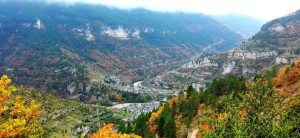
Located at an altitude of 870 m, the classified site of the « Point Sublime » is one of the places in the Tarn Gorge where the view is to cut the breath. Located on the Causse de Sauveterre, Point-Sublime is a lookout that offers visitors the spectacle of these wonderful ochre cliffs plunging into the emerald waters of the Tarn.
At the foot, more than four hundred meters below, the Tarn makes a turn at right angles and this ‘caprice’ allows the visitor to take the gorges in a row, and to the east, and to the south.
Opposite, the steep ledges of the Méjean causse give the final touch to the character of the place and complete this magnificent painting worthy of the greatest artists.
The rune waterfall
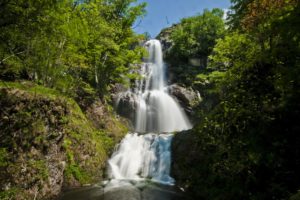
The Runes waterfall is almost sixty metres high with 2 waterfalls, one 46 metres high, plunging into a 7-metre-deep chasm and the other 24 metres high.
The stream originates in the granite rocks of Mount Lozère, and into the Tarn.
It is an exceptional type of landscape for the Cévennes and the Lozère. Carved into the rock, the waterfall offers a place of freshness and shade during your walk.
At the beginning of the fall is an engraved stone: a dragon biting its tail is represented. Inside the circle it is written: « From the earth to the sky and from heaven to the earth. » Local legend has it that some Vikings wandering on Mount Lozère at the end of the first millennium wrote this message.
To see in the area
Video of the Jonte Gorges
https://youtu.be/OMPAgY8WBFU
- Meyrueis
The village of Meyrueis, located at the entrance to the Gorges de la Jonte et at the foot of Mount Aigoual, is ideally placed for a tourist discovery of very rich and varied environments.
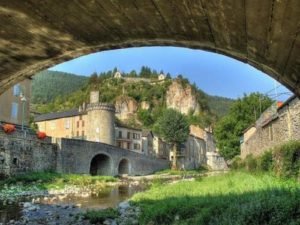
The most likely etymology of Meyrueis certainly comes from the situation of the city at the confluence of several rivers: the Jonte, the Betholon and the Brèze. In Occitan, Meyrueis would mean « mixing streams » from mesclar (mixing) to rius (water streams). The Latin variant Midiis riviis is also sometimes found « in the middle of streams. » From its long history Meyrueis retains a built heritage of quality and character.
Point of contact between the Causses and the Cévennes, With a rich trading and manufacturing past (wool, millinery, etc.) the Meyrueis sector saw the beginning of tourism around the 1880s with the exploration by Edouard Alfred Martel of sites such as Bramabiau, Dargilan, Aven Armand or Montpellier-le-vieux, the first tourist company, ancestor of the current tourist office dates back to 1893.
Also a land of old pastoral tradition, the Meyrueis region retains an important livestock activity, fully included in the Unesco World Heritage Listing Area under the « Cultural Landscapes of Mediterranean Agropastoralism ».
- The sublime dots

he classified site of the « Sublime Point » is one of the places in the Tarn Gorge where the view is to cut the breath. Located on the Causse de Sauveterre, Point-Sublime is a lookout that offers visitors the spectacle of these wonderful ochre cliffs plunging into the emerald waters of the Tarn.
At the foot, more than four hundred meters below, the Tarn makes a turn at right angles and this ‘caprice’ allows the visitor to take the gorges in a row, and to the east, and to the south.
Opposite, the steep ledges of the Méjean causse give the final touch to the character of the place and complete this magnificent painting worthy of the greatest artists.
Retour à la liste






